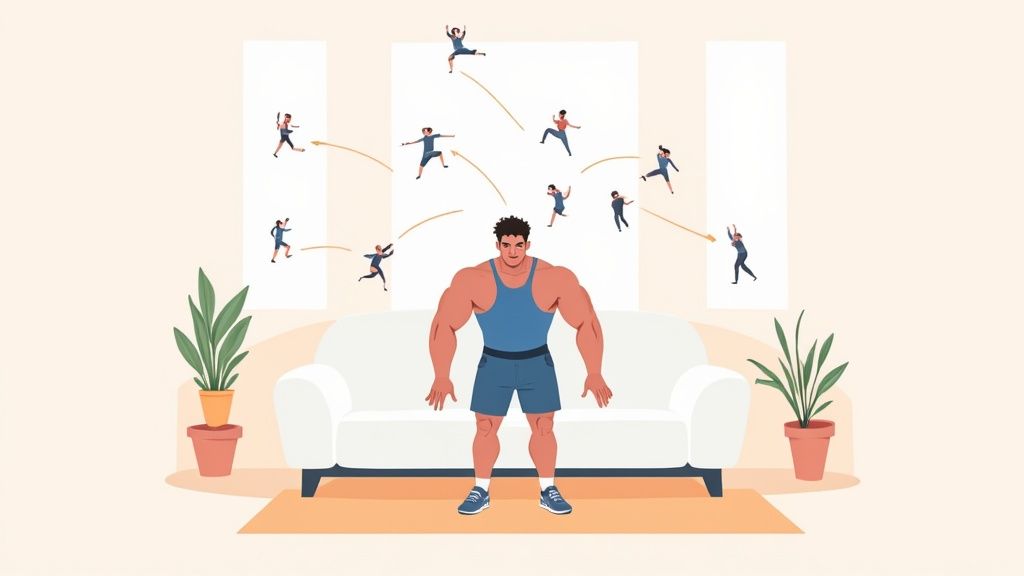Is 30 minutes of cardio really enough to make a difference? Absolutely. Think of it as your daily dose of wellness—a small habit that delivers powerful returns for your heart, mind, and overall health without demanding hours you don't have.
This guide is your complete plan for an effective, equipment-free cardio session you can do right in your living room. We’ll cover why this small time commitment is so powerful, provide a step-by-step workout, and show you how to make it a lasting habit.
Why 30 Minutes of Cardio Is Your Fitness Secret Weapon
Finding time to work out can feel impossible. But here’s the good news: you don't need a grueling, hour-long gym session to see real progress. A consistent 30 minutes of cardio is one of the smartest and most sustainable habits you can build for your health.
It’s the sweet spot—long enough to challenge your cardiovascular system, but short enough to fit into a busy schedule. This approach helps you break free from the "all-or-nothing" trap that so often sidelines our best intentions. Instead of chasing a perfect but unrealistic routine, you're building a practical one. And when it comes to long-term health, consistency always wins over intensity.
The Science-Backed Benefits of a Daily Habit
Committing to a daily cardio session isn't just about feeling good in the moment; the benefits are grounded in solid science and they compound over time.
Think of it as investing in your long-term health. Here’s what you can expect:
- A Healthier Heart: Regular cardio strengthens your heart muscle, helps lower blood pressure, and improves circulation, significantly reducing your risk of heart disease.
- A Brighter Mood: Ever heard of a "runner's high"? Exercise releases endorphins, your body's natural mood-lifters. It’s also an incredible tool for reducing stress and sharpening your focus.
- Sustainable Weight Management: A daily 30-minute session is a fantastic way to burn calories and boost your metabolism, making it easier to manage your weight in a healthy, sustainable way.
- More Energy, Not Less: It might sound counterintuitive, but using energy to exercise actually gives you more energy in the long run. It’s one of the best ways to combat that feeling of daily fatigue.
This infographic breaks down just how impactful that simple daily commitment can be.
This isn't about finding a shortcut; it's about finding an efficient path to your health goals. It's a powerful reminder that real change is built on small, repeatable actions.
The reality is, many adults struggle to get enough movement. A recent report found that nearly a third of adults worldwide don't meet the recommended 150 minutes of moderate-intensity exercise per week. That benchmark is surprisingly easy to hit with just five 30 minutes of cardio sessions. You can read more about these global physical activity trends to get the full picture.
Your Complete 30-Minute At-Home Cardio Routine

Ready to move? Here’s a complete, follow-along plan for a solid 30 minutes of cardio you can do right in your living room. No equipment needed, no complicated moves to learn—just you, a little floor space, and the desire to get your heart pumping.
This routine is designed to be balanced and efficient. We’ll start with a dynamic warm-up to wake up your body, move into the main workout to get your heart rate up, and finish with a proper cool-down to help you recover well.
What You'll Need
The best part about this workout? You need next to nothing to get started.
- A small, clear space: Enough room to move your arms and legs without bumping into furniture.
- Comfortable clothes: Anything you can move and sweat in.
- A water bottle: Keep it handy to stay hydrated.
- A timer: Your phone’s stopwatch works perfectly.
That's it. This workout proves you don’t need a gym membership or fancy gear to get a great cardio session in.
The 30-Minute No-Equipment Cardio Plan
Here’s the full breakdown. The goal is to push yourself during the work intervals and use every second of the short rest to catch your breath before the next exercise.
This complete session of 30 minutes of cardio is built to challenge you without being overwhelming. It activates all the major muscle groups and gives your cardiovascular system a serious boost.
Remember: The goal is progress, not perfection. Listen to your body, modify when you need to, and focus on maintaining good form throughout the entire workout.
Stick with this routine, and you'll build a fantastic fitness foundation. The variety in the movements keeps things interesting and ensures you’re working your body from all angles.
How to Make Your Cardio Workout a Habit That Sticks

Let's be honest: the best workout plan in the world is useless if you don't do it. Consistency is where the real magic happens. The challenge isn't just getting through one 30-minute cardio session; it's making it a non-negotiable part of your week.
First, drop the "all-or-nothing" mindset. If you miss a day, you haven't failed—you're human. Just get back to it the next day. The goal is to build a habit that empowers you, not one that feels like a punishment. The trick is to find where this workout naturally fits into your life, not the other way around. Don't try to force a 6 a.m. run if you're a night owl. Experiment and see what feels best for your body and your schedule.
Find Your Workout Window
Treat your workout time like an important appointment. Look at your week and find a realistic 30-minute slot you can protect.
- Morning Energizer: Getting it done before the day’s chaos begins can set a positive tone and boost your energy levels.
- Lunch Break Burn: A quick midday session is a perfect way to break up the workday and beat the afternoon slump.
- Evening De-Stressor: For some, a workout is the perfect way to shed the stress of the day and clear their mind.
Once you find a time, schedule it. Put it in your calendar with a reminder. You wouldn't cancel an important meeting last minute—give your health that same respect.
True consistency comes from weaving movement into the fabric of your day. Research consistently shows that getting 30 minutes of cardio five days a week dramatically improves health, whether it’s from one structured session or a combination of daily activities.
A landmark study, for instance, revealed that hitting this activity level helped prevent a staggering 1 in 12 deaths. What's really telling is that only 3% of participants achieved this through gym-style workouts alone. In contrast, 38% hit the goal by integrating activity into their everyday lives—think brisk walking on their commute or doing more vigorous household chores. You can read the full study about integrating daily activity to see just how powerful this is. It's a great reminder that all those small, active choices really do add up.
How to Progress and Modify Your Workout
A great workout plan grows with you. The secret to sticking with this 30 minutes of cardio routine is learning how to listen to your body and adjust the intensity. This is what keeps you challenged enough to progress without burning out or getting injured.
Some days you'll feel full of energy, and other days, just getting started is a win. That’s normal. The skill is in adapting the workout to meet you where you are on any given day.
For Beginners: How to Modify and Build Confidence
If you're new to exercise or coming back after a break, your priority is to build a solid foundation safely. Forget about speed or power for now. Your focus should be on good form and gradually building stamina.
Here’s how you can scale it back:
- Take Out the Jump: High-impact moves can be tough on your joints. Instead of jumping jacks, do step-jacks (stepping one foot out to the side at a time). Swap squat jumps for regular bodyweight squats.
- Slow Down the Pace: There’s no prize for speed when you're starting. For exercises like mountain climbers, move with control. A deliberate pace builds strength and prevents injury.
- Increase Your Rest Time: Flip the work-to-rest ratio. Try 30 seconds of work followed by 30 seconds of rest. That extra recovery time makes a huge difference.
Your starting point is just that—a start. It has no bearing on how far you can go. By making these adjustments, you're building the confidence and physical foundation to tackle more intense workouts down the road.
For a Challenge: How to Safely Level Up
Starting to feel like the workout isn’t as tough as it used to be? Fantastic! That means you're getting fitter. To keep seeing results and avoid hitting a plateau, you need to find ways to make it challenging again. This principle is called progressive overload.
Here are a few ways to turn up the intensity on your 30 minutes of cardio:
- Shorten Your Rest: The simplest way to make the workout harder is to cut down on recovery time. Try shrinking your rest from 15 seconds down to 10. It sounds small, but you'll feel it.
- Increase Your Work Time: Instead of the 45/15 split, try pushing your work intervals to 50 seconds with 10 seconds of rest. This challenges your muscular endurance in a new way.
- Add Explosive Power: Focus on making your movements more powerful. Can you jump a little higher in your squat jumps? Drive your knees faster during mountain climbers? Explode from side to side on skater jumps?
Introduce these changes one at a time. The goal is to make the workout harder, not impossible. Give your body a chance to adapt before you add another challenge.
Common Mistakes to Avoid in Your Cardio Workout
It’s often the small details that make the biggest difference. When you're trying to squeeze a session into a busy day, it’s easy to let tiny errors slip in that can stall your progress or even lead to injury.
Let's look at a few common mistakes and how to fix them.
Mistake #1: Skipping the Warm-Up
I get it—you only have 30 minutes and want to make every second count. But jumping straight into high-intensity work is like stretching a cold rubber band. Those first five minutes are non-negotiable for getting your blood flowing and preparing your muscles and joints for the work ahead.
Mistake #2: Letting Your Form Get Sloppy
As you get tired, it's easy to let your form slide. Your squats get shallow, your back rounds during push-ups, and your movements become less controlled. This not only makes the exercise less effective but also puts unnecessary stress on your joints, particularly your back and knees.
The Fix: Focus on quality over quantity. It's better to do 5 perfect push-ups on your knees than 10 sloppy ones on your toes. If you feel your form breaking down, slow down or choose an easier modification.
Mistake #3: Holding Your Breath
When an exercise gets tough, it’s a natural instinct to hold your breath. But this robs your muscles of the oxygen they need to perform.
The Fix: Make your breathing intentional. A good rule of thumb is to exhale on the hardest part of the movement (the "effort") and inhale on the easier part. For a squat, you would inhale as you lower down and exhale as you stand up.
Your Questions About Home Cardio, Answered
It's natural to have a few questions before starting a new routine. Here are answers to some of the most common ones.
How often should I do this 30-minute cardio workout?
Health experts recommend at least 150 minutes of moderate cardio per week. Doing this routine five times a week is a perfect way to meet that goal. However, if you're just starting out, aim for three sessions a week and build from there as you feel stronger. Remember, rest days are just as important as workout days for recovery and progress.
Will 30 minutes of cardio help me lose weight?
Yes, absolutely. A consistent 30-minute cardio session helps create a calorie deficit, which is essential for weight loss. For the best results, pair this routine with a nutritious, balanced diet. But remember, the benefits go far beyond the scale. You're building lean muscle, boosting your metabolism, and making huge strides for your long-term health.
What if I only have 15 or 20 minutes on a busy day?
Something is always better than nothing. If you're short on time, don't skip your workout entirely. Simply do two or three rounds of the main circuit instead of four. Even a 15-minute session will get your heart pumping, release feel-good endorphins, and keep your fitness momentum going.
At Bare Fitness, our mission is to make fitness accessible and achievable for everyone. For more no-equipment workouts and practical health advice that fits your life, explore our resources at Bare Fitness.



















